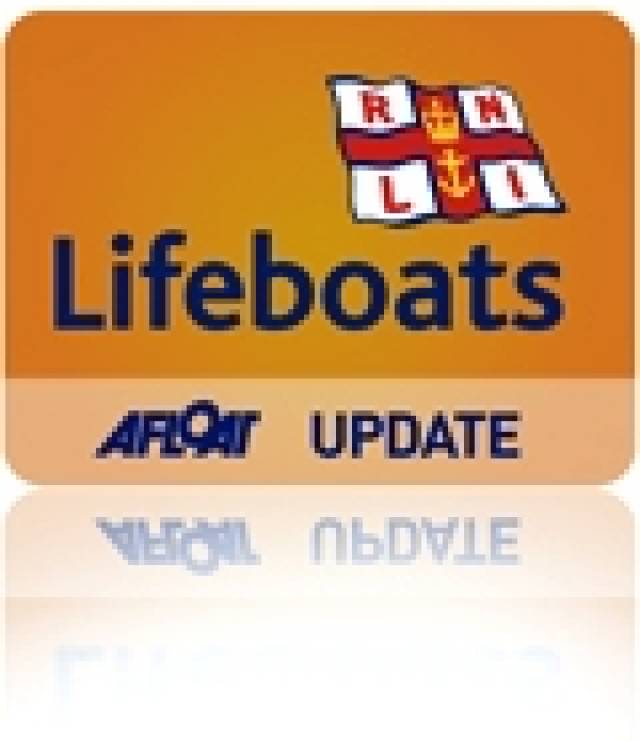#rnli – President Michael D. Higgins, paid a special call to Courtmacsherry RNLI lifeboat station during an official visit to the Cork harbour village over the bank holiday weekend.
The President was accompanied by his wife Sabina and the couple spent some time viewing the historical exhibition in the lifeboat station before unveiling a plaque on the lifeboat station's wall to commemorate the visit. The President and Mrs Higgins then walked through the village where the President addressed the crowds that had gathered in the sunshine on the main street.
President Higgins and Mrs Higgins first stop on arriving in the village was the stone lifeboat station in the middle of the main street which overlooks the harbour and the lifeboat. There he was greeted by Michele O 'Dwyer, Chairperson of the Courtmacsherry fundraising Branch, Barry Flynn, lifeboat station co-ordinator, Coxswain Sean O'Farrell, Lifeboat Mechanic Stuart Russell and Deputy Launching Authority Diarmuid Mahony. They met with the Courtmacsherry RNLI volunteers, station management and former Coxswain and bronze medal awardee Dan O 'Dwyer before viewing the lifeboat exhibition in the station and signing the visitor's book.
The Presidential couple viewed documents and photographs from the sinking of the Lusitania when the Courtmacsherry lifeboat launched with the crew rowing for over three hours in a desperate bid to reach survivors from the torpedoed vessel off the Old Head of Kinsale, Co Cork. They also learned of the lifeboats role in the search and rescue operation following the Fastnet Race tragedy of 1979 where fifteen sailors lost their lives. The Courtmacsherry lifeboat was among of group of RNLI lifeboats which spent 75 hours at sea in 60 knot winds.
Welcoming the President to Courtmacsherry, Courtmachserry RNLI Fundraising Chairperson Michele O'Dwyer said, "We could not have a more distinguished guest. This is a historic day for our village. Courmachserry lifeboat station has a long and distinguished history, being one of the first established stations in 1825. It is my privilege on behalf of Courtmacsherry lifeboat station and the surrounding area of Barryroe to formally welcome the President of Ireland Michael D Higgins and his wife Sabina to Courtmacsherry.
The President then spoke to the crowds gathered in the sunshine and paid tribute to the lifeboat volunteers and the community, "The Courtmacsherry lifeboat service has a long and proud history that stretches back almost two hundred years. There is something extraordinary about both the great promise and the great threat of the sea but even more so by the lives of those who have to deal with it and those in particular who have to use their skill and patience and every characteristic of the human spirit to actually address the position of those who are in difficulties.
Courtmacsherry has had a relationship with the sea that has always called forth the greatest examples of heroism and courage but also practicality and preparation to be able to be of assistance. To be of assistance you have to have so many different characteristics. I think that today in Ireland we must always look and take example and strength from those who give us the greatest examples. I think it is uplifting that in this place that demonstrates so strongly what community means, a lifeboat is there and the community stands behind the lifeboat."
The Courtmacsherry exhibition had a strong emphasis on the lifeboat and its crew with most families in the village having had loved ones serving as volunteer lifeboat crew since 1825. To mark the occasion of the visit of the President and Mrs Higgins, two presentations were made. The first was a piece of sculpture which was presented to President Higgins by volunteer lifeboat crewmember Gearóid O'Donovan, whose grandfather Jack was also a lifeboat volunteer. The piece was called ´circle of friends` and was made by local woman Gillian Noonan. It was to represent the gathering of people in Courtmacsherry for this special occasion and was presented on a wooden plinth turned from local wood by Barry Flynn. Courtmacsherry RNLI fundraiser Martha Drake also presented a bouquet of flowers to Mrs Higgins.
Hundreds of people lined the street in the good weather and the President and Mrs Higgins stayed behind to meet with many of the well-wishers.
































































